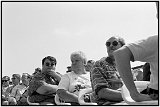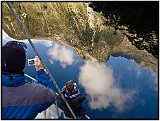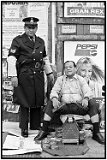"Visual Quotations"
My Photography
I consider myself a street photographer more than I do a "travel" photographer (or nature photographer). I just happen to have ended up on some distant streets and mountains witnessing mostly beautiful to occasionally awful and often funky things. I met fascinating and inspiring human beings everywhere. People are my favorite subject. For both aesthetic and ethical reasons I do not use a telephoto lens. Although it is easy to get a close-up with a long lens, the image loses something because of it. The person is often isolated with no background and no depth of field. There is no context in which to truly get a feel for that person's "essence" or being. It may be more difficult to take a successful environmental portrait, but that is life (no one said photography was easy). Using a 50mm lens necessitates that I have actual interaction with people and have their consent. At the minimum, the subject sees me and can let me know if he/she does not want me to take a photograph. I feel it is wrong to take a photo of someone if they object. Using a telephoto lens might make taking the image possible but it doesn't make it right. And, as I stated, it often doesn't make for a very compelling image. At a market, I will often buy something, say a few words, and then hold up my camera and smile. If they block their faces, I put it down and don't take the shot.*
To get the shot below left of the cop and the shoeshine man I approached the policeman and asked for directions. I struck up a conversation with the two of them and after a few minutes of chit-chat I asked if I could take a photo. The policeman, who was in the middle of getting a shine, said to wait, for this position was not dignified. I waited. The result was three portraits. The best one is shown here. I was surprised because Buenos Aries policemen are not known for their congeniality. I find that it is often just such interpersonal contact that opens people up and puts them at ease enough to put up with me. One must build a trust in only a few minutes or seconds. This may not be easy for everyone to do. Everyone has something different to work with, and she/he should use this in her/his artwork. It is what makes us different; what makes our interpretations different; what makes our art different. We should celebrate this difference while remembering that, in the end, we are all humans with the same needs and desires: to live a meaningful life with dignity in a just world. I try and communicate this message in my images.
Inspirations:
The single most influential figure on my work is Henri Cartier-Bresson, one of the founders of the Magnum Photo Agency. The agency was a cooperative started in 1947 by Robert Capa, Cartier-Bresson, George Rodger, and David "Chim" Seymour. Cartier-Bresson describes the purpose of the agency as "... a community of thought, a shared human quality, a curiosity about what is going on in the world, a respect for what is going on and a desire to transcribe it visually." I share with this sentiment a concern for our shared humanity and hope that through visual communication I can do a little something to help people remember this. From Cartier-Bresson I also got the notion of using the entire negative. It is so small to begin with, one should use it all! I virtually never crop. This has really helped me develop a sense of composition. I find it a challenging game to line up all the elements within the frame and depress the shutter when everything lines up at, as Cartier-Bresson also said, "the decisive moment." Mirror LakeThis moment refers to that instance when everything in the view finder, all the elements, both controlled and uncontrollable, just fall into place for a brief 1/1000 of a second, and the shutter is depressed. "click." I also love Robert Frank, Weegee, André Kertész, Eugène Atget, and other masters of documentary photography.
A great challenge I find is to show humor in photography beyond a mere visual pun. An image that is inherently humorous. Gary Winogrand was great at this. But the photographer whose eye gives me the most to work with is Elliot Erwitt, particularly his book entitled "On the Beach." Images I have been taking over the years of tourists I find quite playful (the one belown the right and others to be posted). The image below center has a nice playful feel, as well as being a kind of "decisive moment." Also, the images of the Eiffel Tower that are up on this site work quite well. Other general influences come from Milton Rogovin, Edward Weston, Sebastião Salgado, Susan Meiselas, and so many more contemporary fine art and documentary photographers, as well as many filmmakers (such as Jean Rouch, John Sayles, Jim Jarmusch, David MacDougall). All of these artists, and others, have inspired my work and are at the core of my vision and aspirations.
*I do use a long lens at concerts and at local nature parks to photograph wildlife. I wish I had one in Kenya on safari!
©2017 Richard Freeman. All rights reserved.


